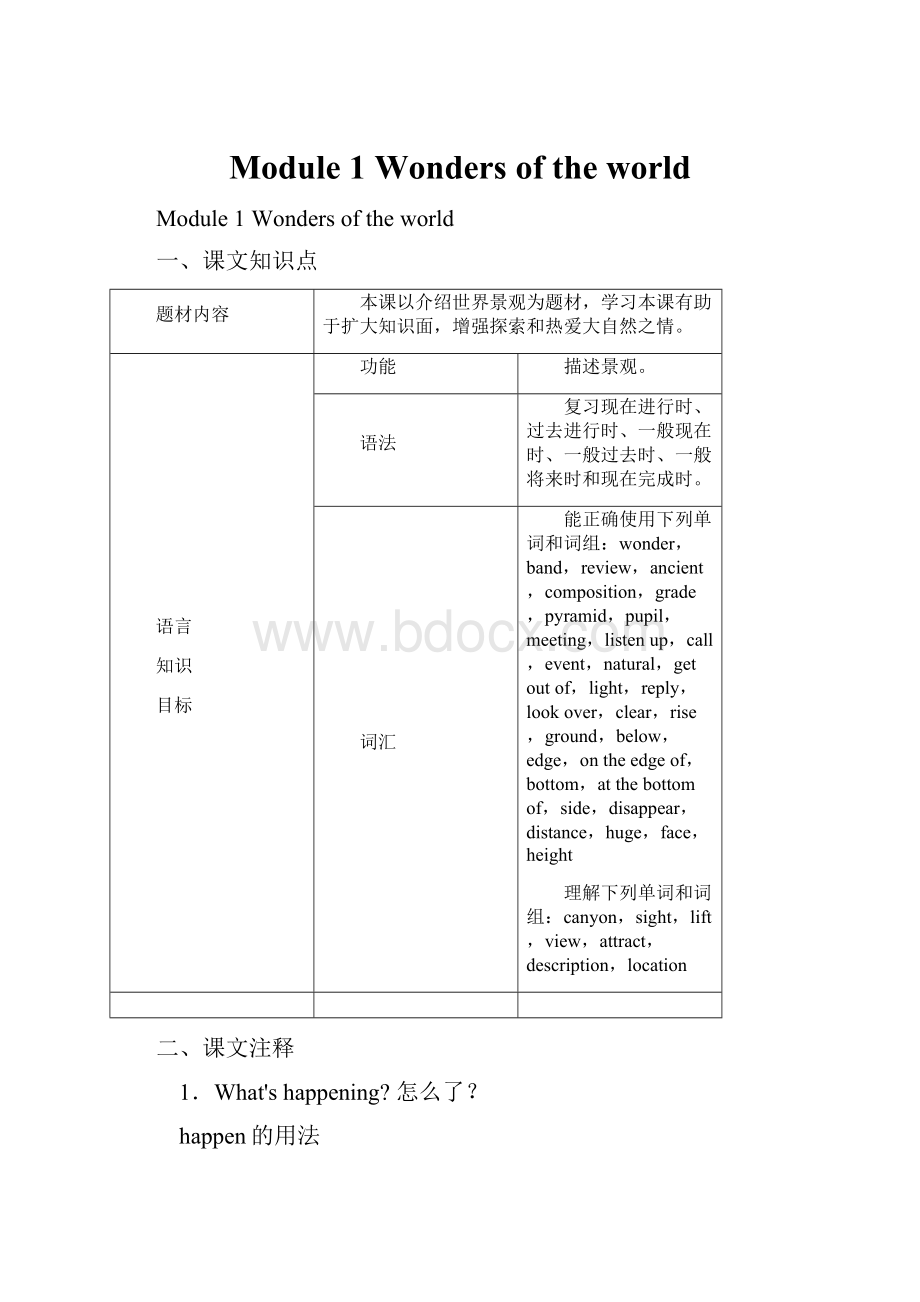Module 1 Wonders of the world.docx
《Module 1 Wonders of the world.docx》由会员分享,可在线阅读,更多相关《Module 1 Wonders of the world.docx(20页珍藏版)》请在冰豆网上搜索。

Module1Wondersoftheworld
Module1Wondersoftheworld
一、课文知识点
题材内容
本课以介绍世界景观为题材,学习本课有助于扩大知识面,增强探索和热爱大自然之情。
语言
知识
目标
功能
描述景观。
语法
复习现在进行时、过去进行时、一般现在时、一般过去时、一般将来时和现在完成时。
词汇
能正确使用下列单词和词组:
wonder,band,review,ancient,composition,grade,pyramid,pupil,meeting,listenup,call,event,natural,getoutof,light,reply,lookover,clear,rise,ground,below,edge,ontheedgeof,bottom,atthebottomof,side,disappear,distance,huge,face,height
理解下列单词和词组:
canyon,sight,lift,view,attract,description,location
二、课文注释
1.What'shappening?
怎么了?
happen的用法
happen是不及物动词,它的用法常见的有如下几种情况:
1)表示“某地(某时)发生了什么事”,常用“sth.+happen+地点/时间”这一结构来表达,此时主语应是事情。
例如:
Thestoryhappenedin2003.这个故事发生在2003年。
Anaccidenthappenedinthatstreet.那条街上发生了一起事故。
2)表示“某人出了某事(常指不好的事)”,要用“sth.+happen+tosb.”这一结构来表达。
例如:
Acaraccidenthappenedtoherthismorning.今天上午她发生了交通事故。
Whathappenedtoyou?
你怎么啦?
3)表示“某人碰巧做某事”,要用“sb.+happen+todosth.”这一结构来表达。
例如:
Ihappenedtomeetafriendofmineinthestreetyesterday.昨天我碰巧在街上遇到了我的一个朋友。
4)happen表示“碰巧或恰巧发生某事”时,还可用“Ithappens/happenedthat...”这一结构来表达。
例如:
IthappenedthatBrianandPeterwereathomethatday.碰巧那天布莱恩和彼得在家了。
Ithappenedthathehadtotakepartinameetingthatafternoon.碰巧那天下午他不得不参加一个会议。
注:
that从句中的主语是人时,此种结构可以与“sb.+happen+todosth.”结构互换。
例如:
IthappenedthatBrianandPeterwereathomethatday.=BrianandPeterhappenedtobeathomethatday.
2.Whydon'twestartaschoolmagazine?
我们为什么不创办一本校刊?
start和begin的用法
一、相同之处
1)意为“开始;发生;发起”时,两者可互换。
如:
Thenhebegan/startedaseriesofexperiments.然后他就开始做一系列的实验。
Howdidtheaccidentbegin/start?
事故是怎样发生的?
2)表示开始某一动作时,后面跟不定式或动名词所表达的意思是相同的。
但当表示开始一项较长时间或经常性的活动时,后接动名词的形式则更为常见。
如:
Thechildbegancrying/tocry.那小孩开始哭了。
3)两者在下列情况下常接不定式,不接动名词:
(1)主语是无生命的事物,而不是人时。
如:
Theicebegan/startedtomelt.冰开始融化了。
(2)当begin和start用于进行时态时。
如:
Theplasterwasbeginning/startingtofallfromthewalls.墙上的灰泥开始脱落了。
(3)当begin和start后接表示心理状态或精神活动的动词时。
如:
Marybegan/startedtoguesswhatisinthebag.玛丽开始猜包里有什么东西了。
4)两者都具有及物动词词性和不及物动词词性。
Whattimedoyoubegin/startschool?
你是什么时候开始上学的?
5)begin/startwith意为“从……开始”。
如:
WhichlessonshallIbegin/startwith?
我应从哪一课开始?
6)begin和start均为终止性动词,因此不能与段时间状语连用。
如:
电影开始10分钟了。
误:
Thefilmhasbegun/startedfortenminutes.
正:
Thefilmbegantenminutesago.
正:
Thefilmhasbeenonfortenminutes.
正:
It'stenminutessincethefilmbegan.
二、不同之处
1)表示(机器)开始、启动时,用start,不用begin,时此的start相当于setgoing.如:
Howdoyoustartthewashingmachine?
洗衣机怎么启动?
Themancan'tstartthecar.这个人无法发动这辆车。
2)表示创办、开设时,用start,不用begin.此时的start相当于setup或establish.如:
Hestartedanewshoplastyear.去年他新开了一家商店。
3)表示动身、出发、启程时,用start,不用begin,此时的start相当于setout或setoff.如:
HestartedforAmericalastweek.他上周动身去美国了。
4)表示开始使用时,用start,不用begin,此时的start相当于begintouse.如:
Youhaveusedupthisbottleofink.Willyoustartanotherone?
你已用完了这瓶墨水,打算再用一瓶吗?
。
3.Anyoneelse?
还有其他的吗?
else的用法浅析
一、用在不定代词anybody,everything,someone,nothing,somebody及不定副词somewhere等后面。
Idon'tknowanythingelse.此外我什么也不知道。
Nobodyelsecoulddothis.
Wasanybodyelseabsent?
Ihadnothingelsetodo.
二、用在who,what,where,how,when,why等疑问代词或疑问副词后面。
Whatelsedidshetellyou?
Whoelseiscoming?
WhereelsehasTombeenbesidesNewYork?
三、用在all,little后面。
Ifourpolingiswrong,allelsewillbewrong.
政策错了,什么都错了。
Littleelseremainstobedone.应做的事差不多都做完了。
注意:
else's
Mary'shairislongerthananybodyelse'sinherclass.
四、在or后面,“否则,要不然”。
Bequick,orelseyouwillmissthetrain.
Hemusthavebeenjoking,orelsehewasmad.
4.Wonder的用法
a.(常与at,that连用)觉得奇怪;惊奇
Iwonder,InEngland,eachmanspeaksadifferentlanguage.
我感到十分惊奇,在英国每个人都说着一种语言。
Iwonderathisrudeness.
我对他的粗鲁感到奇怪。
b.纳闷;想知道
Hewonderedwhypeoplebuiltuglyhomes,whentheycouldhavebeautifulones.
他很奇怪为什么人们本可以造出漂亮的房屋,而偏偏建造出丑陋的房子来。
IwonderwhyJamesisalwayslateforschool.
我想知道为什么詹姆斯上学总是迟到。
Unit2IwasontheedgeoftheGrandCanyon.
1.WhenIarrived,itwasearlymorning.我到达那儿的时候是个大清早。
arrivereachget的用法
arrive为不及物动词,当到达的是较大的地理区域时用介词in,而到达较小的地方时则用at,如:
arriveinNewYork,arriveatthevillage.
而reach则是及物动词。
如:
Howdidyoureachtheschoolthismorning?
而get可用作不及物动词,作"到达"讲时其后面多与to连用。
如:
WhendidyougettoNewYork?
〔误〕IarrivedBeijingthedaybeforeyesterday.
〔正〕IarrivedinBeijingthedaybeforeyesterday.
〔正〕IreachedBeijingthedaybeforeyesterday.
〔误〕Hearrivedintheschoolat11∶00.
〔正〕Hearrivedattheschoolat11∶00.
2.Intheeast,theskywasbecominglight.在东方,天空正在泛白。
intheeast用介词in.表示在东方。
Thesunrisesintheeast.
3.Afteraboutakilometer,astrangerappearedinfrontofme.
大约走了一公里,一个陌生人突然出现在我面前。
infrontof的用法
infrontof“在....的前面”用于两者事物不在同一空间内。
例如:
Thetreeisinfrontofthehouse.“这棵树在房子的前面。
”
inthefrontof“在.....的前面”,但是用于两者事物在同一空间内。
例如:
Tomisinthefrontoftheclassroom.Tom在教室的前面。
4.You'llgotthereinfiveminutes.你将在5分钟后到达。
infiveminutes5分钟以后
通常用于一般将来时
—Howsoonwillhecomeback?
他多久以后回来?
—Intendays.十天后。
5.butitwasstilltoodarktoseeanything.
但是太黑仍旧看不见任何东西。
too+形容词/副词+动词不定式“结构简称为"too...to”结构。
这种结构是英语中常用的一种句型,在大多数情况下表示否定意义,在翻译时,通常可译为“太……而不能……”、“太……无法……”。
句型I:
too+adj./adv.+todo这个句型是too...to的最基本的常用句型。
too+形容词或副词,有时too后也可跟一个起形容词作用的过去分词。
例如:
Theboyistooyoungtogotoschool.这男孩年龄太小,不能上学。
Thehatistoolargetowear.这帽子太大,没法戴。
Hewalkstooslowlytogetthereontime.他走得太慢,不能按时到达那儿。
I'mtootiredtothinkofanythingnow.我太累了,什么也不能想了。
句型II:
too...to+tobeV-ed这是“too...to”结构中不定式为被动式时的变体,如果主语是不定式动作的承受者,不定式既可以用主动式,也可以用被动式,此时用主动式虽然在形式上是主动的,但在涵义上却是被动的。
例如:
Theteaistoohottodrink/tobedrunk.茶太热,不能喝。
6.I'lldosomereviewsaboutourfavoritebandsandmovies!
我要就我们喜爱的乐队和电影多一些评论。
AndI'lldoaninterviewwithhim.我要采访他。
dosomereviews“对……做评论”
doaninterview采访
Ishoulddomoreexercise.我应该多锻炼。
He'sanhonestperson.weliketodobusinesswithhim.
他是一个诚实的人,我们愿意与他做生意。
7.That'snewstome!
That's/It'snewstome.意思是“我在被告知这件事以前根本不知道”,特别用于感到惊讶和愤怒时。
如:
①There'snoclasstomorrow?
That'snewstome!
明天不上课?
我一点都不知道。
②—IhearyouandpawlaregoingtoParisfortheweekend.我听说你和保罗要去巴黎度周末。
—Really?
That'snewstome.是吗?
我怎么不知道。
8.Ithinkthat'safantasticidea…
fantastic常用在口语中,表示“了不起的;极好的”。
如:
Youpassedyourtest?
Fantastic!
9.Igotoutofthecar,wentthroughagateandwalkedalongapath.
介词through可与很多动词连用,组成动词短语。
如:
TheRiverThamesflowsthroughLondon.
Themangotinthroughthewindow.
Youcanseethroughglass.
10.Suddenly,thecloudsclearedandtherainstopped.
clear在本句话中作动词,意思是“天气放晴,转晴”,它还可作形容词和副词,作形容词时有很多种意思。
如:
Thewaterinthelakeisclear.(清澈的,透明的)
Hegaveaclearexplanation.(易懂的,明白的)
Itisquiteclearthatsheisnotcoming.(明显的,显然的)
11.Thesunrosebehindmeandbeyondtherocks.
rise意思是“上升,起身”,不及物动词,过去式和过去分词分别为rose,risen。
raise很易与其混淆,raise有“举起;召集,筹措;抚养”之意,为及物动词,过去式和过去分词分别加-ed。
如:
raiseone'shand举手
raiseanarmy招募军队
raiseafamily养家
12.…over400kilometerslong.
英文中表达长、宽、高、深等概念时,结构为“数字+单位+long/wide/high/deep”。
如:
threemetreswide宽3米
ninemetresdeep9米深
Unit3Languageinuse
语法:
一般现在时和一般过去时 现在进行时和过去进行时的用法
1.一般现在时的用法
1)经常性或习惯性的动作,常与表示时间的状语连用。
时间状语:
every…,sometimes,at…,onSunday
Ileavehomeforschoolat7everymorning.
2)客观真理,客观存在,科学事实。
Theearthmovesaroundthesun.
ShanghailiesintheeastofChina.
3)表示格言或警句中。
Pridegoesbeforeafall.骄者必败。
注意:
此用法如果出现在宾语从句中,即使主句是过去时,从句谓语也要用一般现在时。
例:
Columbusprovedthattheearthisround..
4)现在时刻的状态、能力、性格、个性。
Idon'twantsomuch.
AnnWangwritesgoodEnglishbutdoesnotspeakwell.
比较:
NowIputthesugarinthecup.
Iamdoingmyhomeworknow.
2.一般过去时:
(1)过去某个特定时间发生,并且一下子就完成了的动作(即:
非持续性动作)。
(2)也可以表示过去习惯性的动作。
一般过去时不强调动作对现在的影响,只说明过去。
IhadawordwithJuliathismorning.今天早晨,我跟朱丽亚说了几句话。
Hesmokedmanycigarettesadayuntilhegaveup.他没有戒烟的那阵子,烟抽得可凶了。
一般过去时常与表示过去的时间状语或从句连用,如:
yesterday,lastweek,in1993,atthattime,once,duringthewar,before,afewdaysago,when等等。
3.过去进行时
1)主要表示过去某个时刻或某一阶段正在进行的动作,常和表示过去时间的状语then,atthis(that)time,yesterday,atnine,lastnight等连用。
但在不少情况下,没有表示时间的状语,这时需要通过上下文来表示。
Whatwereyoudoingatninelastnight?
昨晚九点时,你在做什么?
Icalledyouyesterdayafternoonbuttherewasnoanswer.
昨天下午我打电话给你,但是没有人接电话。
Iwasvisitingafriendofminemostoftheafternoon.
我昨天下午大部分时间,都在一个朋友家里。
2)当两个一长一短的动作在过去某时间同时发生时,用过去进行时表示较长的动作。
过去进行时可用于主句,也可用于从句。
ItwasraininghardwhenIleftmyoffice.
当我离开办公室时,雨下得正大。
Whenyoucalled,Iwaseating.
你打电话时,我正在吃饭。
WhenIwascleaningthewindows,mybrotherwassweepingthefloor.
(当)我在擦窗户的时候,我弟弟在拖地。
TheywerewatchingTVwhenthelightswentout.
停电时,他们刚好在看电视。
4.现在进行时
现在进行时由“be+v-ing”构成。
be应为助动词,初学者最容易漏掉,它应与主语的人称和数保持一致。
在实际运用时,现在进行时常用以下几种情况:
(1)当句子中有now时,常表示动作正在进行,这时要用现在进行时。
如:
Theyareplayingbasketballnow.现在他们正在打篮球。
(2)以look,listen开头的句子,提示我们动作正进行,这时要用现在进行时。
如:
Listen!
SheissinginganEnglishsong.听,她正在唱英语歌。
(3)表示当前一段时间或现阶段正在进行的动作,且此时有thisweek,thesedays等时间状语,这时常用现在进行时。
如:
Wearemakingmodelplanesthese